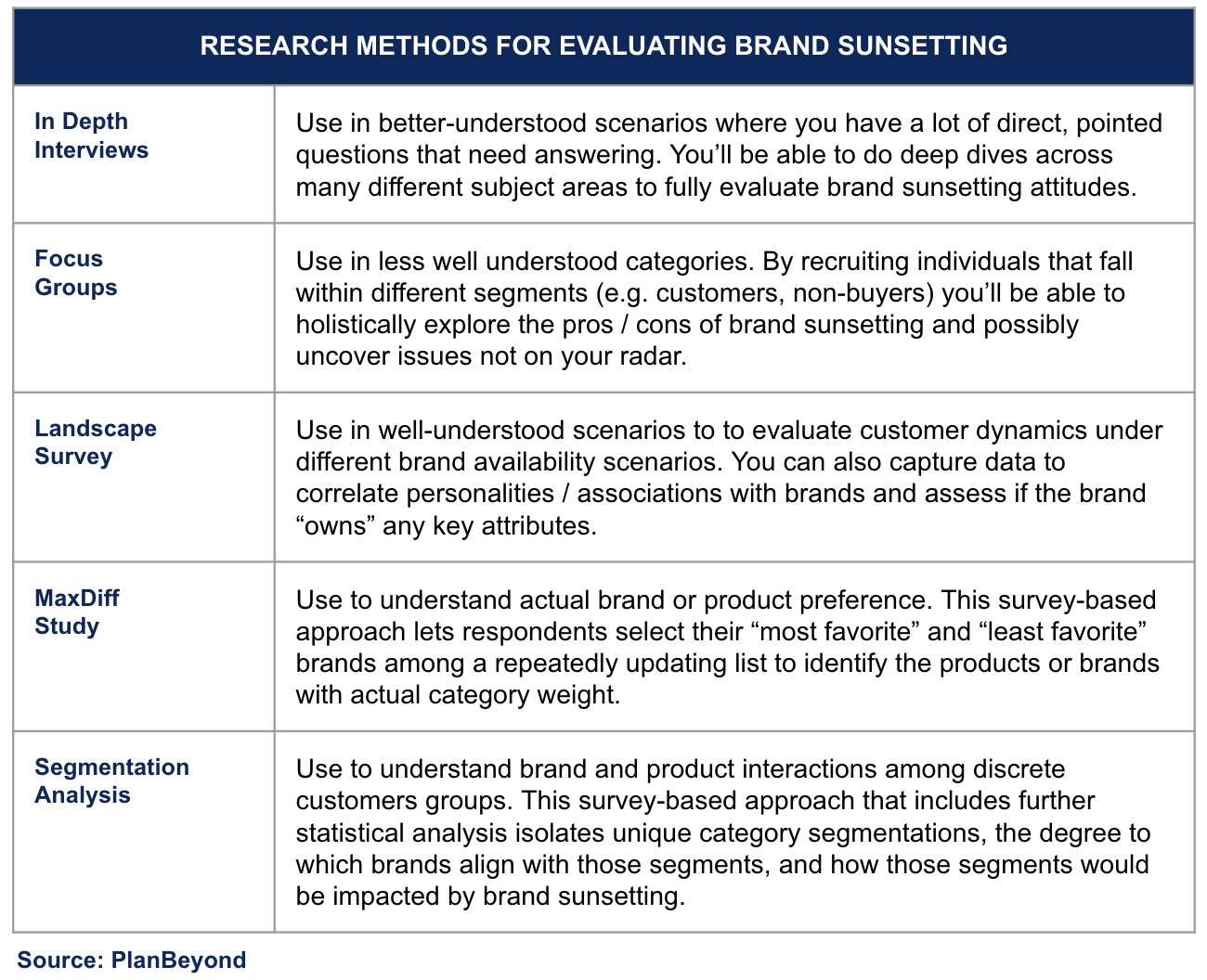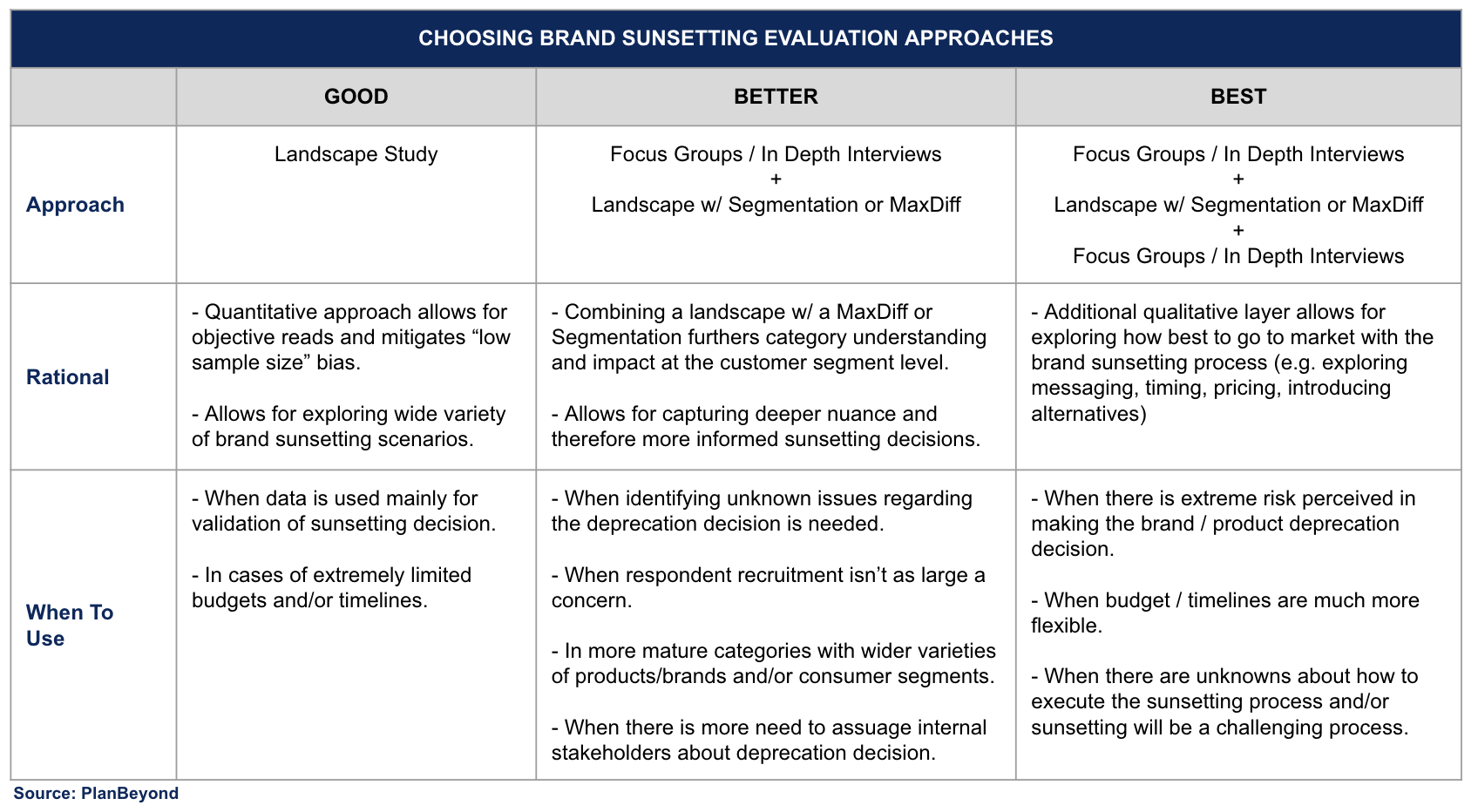It takes a lot to build a well-loved, revenue-driving brand. But, sometimes, brands lose their luster. Maybe they just don’t keep up with the times. Perhaps they represent outdated technology or ideals. Or, they possibly just haven’t gotten the investment needed to stay bright and shiny.
Regardless of what leads to this point, the fact remains that it drives teams to ask a critical question: Is it time to sunset the brand?
It’s a controversial question, ripe with potential discontent from long-loyal customers and influential internal stakeholders. But, it’s a critical one to ensure resources are used on the right brands.
By evaluating the broader implications of brand sunsetting on customer sentiment and competitive dynamics, organizations are well-equipped to confidently make the go / no-go decision.
What Does It Mean To Sunset A Brand
Sunsetting a brand or product refers to the intentional phasing out of that item and making it no longer available for purchase. This is a deliberate choice on the part of an organization, often driven by seeing that the brand or product no longer produces enough revenue or other reputational value to justify the cost of bringing it to market.
The decision to sunset a brand often comes at key inflection points. For instance, organizations undergoing mergers or acquisitions may find that they have competing or redundant brands. Or, organizations with robust brand portfolios developed over time may see too much customer overlap across brand usage.
These inflection points are ideal times to have strategic conversations about the value, or lack thereof, of each brand to the broader organization.
What Information Impacts The Brand Sunsetting Decision
It likely goes without saying that massively profitable, huge revenue-driving brands aren’t typically on the chopping block. Instead, questions about sunsetting a brand typically begin when revenue volume dips. These are likely year-over-year declines that represent a long-term trend in brand revenue. Over time, these declines flat line and hold steady at less-than-ideal rates.
However, revenue volume is often not a sufficient reason alone to “kill” a brand or product. There are many critical considerations to keep in mind when making this potentially controversial decision.
Brand Differentiation
Brands, by their very definition, stand for ideals, perceptions, and other intangibles “owned” by a product or service. It’s the thing that lets you put a price premium on an item. Organizations spend incredible sums of money and resources to create brands. But, sometimes, those brands lose their luster.
Before deciding to sunset a brand, it’s important to understand if the brand does have this differentiating power. If it does, there may still be time to revitalize it. If not, this could be an additional reason to put it on the chopping block.
Product or Brand Replacements
Taking a brand off the market means customers will (likely) purchase something else in its place. As a result, we must understand what the most likely replacement brand or product is.
Is the replacement a brand your organization owns? Or, would customers actively replace your brand with something owned by a competitor?
You’ll want to understand replacement dynamics to determine if sunsetting a brand reduces market share or cedes market power in undesirable ways.
Customer Segments
Typically, unique brands attract unique customer groups or segments. These segments may be incredibly valuable due to their brand loyalty or the cache they bring to the wider brand or product line. Or, they may not.
Before deprecating the brand, explore the degree to which it aligns with distinct segments, and who is in those segments. These could be groups you’d be crazy to lose, or they could be segments that do not hold much material value to your business.
Brand Sunsetting Process
Even if an organization is onboard with sunsetting a brand, you’ll need to evaluate how to approach that process.
Will you simply remove it and see what happens? Or, will you try to introduce replacements? Along those lines, you’ll need to evaluate timing, messaging, and price implications. Finding the ideal way to sunset a brand is worth it since it means maintaining customer goodwill and, with it, revenue opportunities.
Evaluating Brand Sunsetting Dynamics
All of the dynamics above have a material impact on deciding whether or not to shut down a brand or product. As a result, they warrant objective exploration to see if it’s time to pull the plug. The table at the right outlines the five research methods we typically consider when doing brand deprecation work and the value we get from each one.
1. In Depth Interviews
2. Focus Groups
3. Landscape Surveys
4. MaxDiff Studies
5. Segmentation Analysis
While all of these options directly answer brand deprecation questions, the option you choose depends on several dimensions. The first is business context. B2C categories, and the relative ease of finding respondents, often makes any of these options viable. Meanwhile, B2B categories sometimes have niche customer types. This often makes studies that require higher sample sizes like segmentation analysis or MaxDiff studies less viable.
Another dimension is overall understanding of the issue. If you’re entering with a lot of unknowns, you should leverage qualitative methods like interviews or focus groups. However, if the topics are well understood and you’re looking for clearer validation, it’s okay to jump to survey-based approaches.

Choosing The Right Evaluation Approach
With so many research options to consider, which one should you choose? The ideal answer is more than one.
Let’s look at the scenarios below to suss this out.
Low Risk / Smaller Budget…Is the brand sunsetting process relatively low risk? And, do you have limited budgets to work with? If so, you can likely get away with a landscape study. You’ll have sufficient samples sizes to build decent confidence levels and you’ll have data on different brand deprecation scenarios.
Moderate Risk / More Unknowns…Are you entering the sunsetting question with a lot of unknowns? If so, you’ll want to consider beginning with open-ended interview or focus groups followed by survey-based approaches. This one-two punch lets you identify issues not currently on your radar while adding in a validation layer.
High Risk / A Lot Of Unknowns / Deep Budget…Is brand sunsetting a risky, controversial move? And, are you equipped with the time and budget to really explore the topic? If so, start exploring the unknowns with focus groups or interviews and then follow for more exploration and validation with a survey. If sunsetting still seems a-go, finish up with additional qualitative research to explore how best to go-to-market with the sunsetting process.







